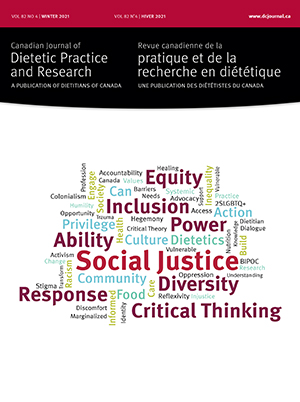Malnutrition in older home care clients referred to dietitians: A descriptive study
J. Pinto, M. Storey, S. Brousseau, S. Cecchini, A. Kwong, H. Mohamed, C. Ryan, M. Weatherbee, T.R. Fenton. Alberta Health Services, Calgary, AB
Introduction: Malnutrition is generally under-recognized in older adults. Limited data exists on nutrition risk and malnutrition of older home care clients referred to dietitians.
Objectives: The objectives are to determine the prevalence of malnutrition and nutrition risk among those referred to the home care dietitians and describe clients’ clinical characteristics.
Methods: We conducted a descriptive study of completed dietitian referrals for malnutrition and nutrition risk for home care clients 65 years and older received from home care professionals between May 1 to October 31, 2020. Demographics, referral reason, and clients’ clinical characteristics were collected and analyzed using descriptive statistics. Referred clients were identified malnourished, at nutrition risk or not at nutrition risk based on clinical symptoms using the Global Leadership Initiative on Malnutrition (GLIM) criteria.
Results: Home care dietitians received a total of 476 home care referrals, of which 205 (43%) were 65 and over. For clients 65 and older, 98 were referred for signs and symptoms suggestive of nutrition risk (e.g., weight loss, cachexia, poor intake, and poor appetite). An additional 64 clients referred for other reasons were identified during dietitian assessment, for a total of 159 (78%) clients with nutrition risk or malnutrition. Of the 159 clients with nutrition risk or malnutrition: 54% (n = 110/205) were identified with malnutrition, 24% (n = 49/205) at nutrition risk, while 22% (n = 46/205) were not found to be at risk. Age of referrals ranged from 65 to 102 years (mean age = 82, SD = 8.3), with 54.9% identified as females. Mean Body Mass Index (BMI) was 22.9 kg/m2 and 45% of referred clients were underweight (BMI < 22). Fifty-six percent (n = 90) of referred clients experienced significant weight loss and 68.5% (n = 111) reported reduced food intake in the previous two weeks.
Conclusions: Malnutrition is an important concern for home care clients. Seventy eight percent were found at nutrition risk and 54% were found to have malnutrition. Our study provides evidence that malnutrition is prevalent among this population and supports the need for early identification of nutrition risk in home care clients.
Significance: This study provides baseline data for developing and evaluating future interventions to increase malnutrition awareness in the Home Care Program.



